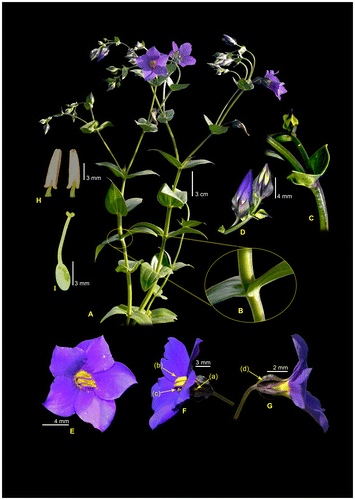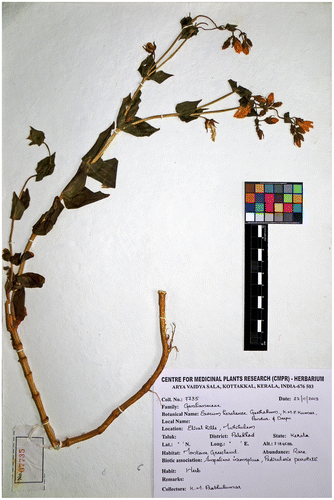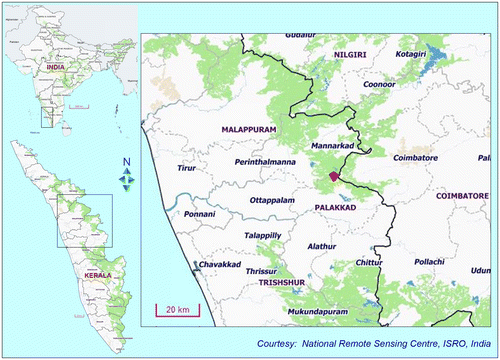Abstract
Exacum keralense, a new species from montane grasslands in Western Ghats, India, is described. The new species is similar to Exacum atropurpureum and mainly differs in having a violet-coloured calyx with thick wings, rectangular curved anthers with sagittate base and style shorter than stamens with bilobed stigma. The morphological characters, distribution map, conservation status and images of the new species are provided.
Keywords:
Introduction
The genus Exacum L. comprises about 70 species distributed from East Africa throughout India and Sri Lanka to southern Asia and Australia (Klackenberg Citation1983, Citation1985, Citation2002; Thulin Citation2001; Pietraszek Citation2015). There are two centres of diversity for this genus: Madagascar, and southern India and Sri Lanka (Klackenberg Citation1985). In India, it is represented by 22 species of which 10 are considered to be endemic (Klackenberg Citation1985; Garg Citation1987; Biswal et al. Citation2011). About 14 species are known to occur in Western Ghats, of which seven are endemics (Nayar, Raziya Beegam, and Sibi Citation2014).
During a botanical expedition to the Elival hills of the Muthikulam forest area, Palakkad District, Kerala, we found an unusual population of Exacum similar to Exacum atropurpureum in general morphology but differing from the latter species in several important characters. We determined that the specimens can be morphologically well-distinguished from related taxa, and they are described here as a new species.
Materials and methods
The plant specimens were collected at the Elival hills of Palakkad District, Kerala, India. Measurements of the parts of the fully matured plants were made from fresh material. They were critically studied using the revision of the genus Exacum made by Klackenberg (Citation1985). Regional herbaria (CALI, MH, TBGT, CMPR and UCT) were also searched for additional specimens. The Virtual herbaria C, E, K, MO, NY and US were also consulted. The type specimens were deposited at the herbaria CMPR, TBGT and K. Acronyms of herbaria are used according to Index Herbariorum (Thiers Citation2016).
Taxonomy
Exacum keralense Geethakum., K.M.P.Kumar, Pandur. & Deepu sp. nov. (Figure )
Figure 1. Exacum keralense sp. nov. (A) Habit. (B) Stem clasping leaf base. (C) Flowering branch, (D) Flower buds with violet coloured calyx lobes. (E) Flower – front view. (F) Flower– side view (a. Yellow coloured corolla tube, b. Curved stamens, c. smaller style). (G) Flower – side view showing keeled calyx wings (d). (H) Stamens. (I) Pistil. Photos K.M.P. Kumar.

Diagnosis
Exacum keralense resembles E. atropurpureum, but it can be easily distinguished by loosely, dichotomously branched inflorescence in its upper part, flowers with violet calyx, rectangular curved anthers with sagittate base, style shorter than stamens, and bilobed stigma.
Holotype. INDIA. Kerala: Palakkad district, Elival hills, Muthikulam, altitude 1845 m, 10°56'12" N, 76°38'26" E, 22 November 2013, K. M. Prabhukumar 7735 (CMPR!; iso: TBGT!, K!) – Figure .
Description
Annual, 30–60 cm high. Stem terete to 4-lineolate, sometimes with adventive roots in the lower nodes, laxly dichotomously branched in its upper part. Leaves sessile, ovate, 2.3–4.6 × 1.5–2.6 cm, thick, glabrous, green, base (sub)cordate, clasping, apex acute, nerves (3–)5, abaxially prominent. Flowers in terminal dichasial lax cymes or solitary in leaf axil; peduncles 2.5–4.5 cm long; pedicels slender, not winged, 5–10 mm long, enlarging in fruit to 25 mm. Calyx 5-lobed, violet, 4–5 × 7–9 mm; tube campanulate; lobes narrow, 6–8 mm long, acuminate, coalescent to one-sixth of their length; wings 1.5–2 mm broad, thick and keeled, without prominent veins, accrescent in fruit. Corolla 5-lobed; tube 1.5–2 mm long, yellow, lobes broadly elliptic, 8–12 × 4–6 mm, apex acute, deciduous, deep blue to violet, base yellowish (near throat), nerves not prominent. Stamens 7.5–8.5 mm long; anthers rectangular, curved, base sagittate, 6–7 mm long, opening by apical pores, with the small papillae near the apex on the dorsal side; filaments c. 1.5 mm long, attached at the throat of the corolla tube. Ovary ellipsoid, c. 3 mm long; style shorter than stamen, 5–6 mm long, straight, stigma bilobed. Capsule ellipsoid, 9–10 mm long, slightly curved. Seeds irregularly rhomboid, angular with shallowly sunken sides.
Phenology
The plant was observed to be flowering and fruiting in November; more information about the phenology will be provided after further investigations.
Etymology
Named after the State – Kerala –,where the material is collected.
Distribution and ecology
India: Western Ghats – Kerala state, Palakkad district (Figure ). The species grows on the montane grasslands of the Elival hills in the Muthikulam plateau at an altitude of ~1800 m, located in Mannarkad Forest Division, which borders the northwestern portion of the Western Ghats on the northern side of Palakkad Gap in Mannarkad Taluk. The new species has been collected from a single locality, and its distribution falls within the Nilgiri-Silent Valley hotspot of the Western Ghats biogeographic zone, which constitutes one of the centres of endemism in Indostan (Pandurangan, Suiting, and Rai Citation2012).
Conservation status
Exacum keralense is currently only known from one population and therefore has a very restricted distribution range. This specific area is botanically poorly explored and it is highly likely that other populations could be found in similar habitats in the area. The populations discovered are relatively small (30 plants per locality) but apear well-developed with no sign of negative impact at present. However, this area is under wild grazing and overgrazing could change the threat status, hence it is categorised as Vulnerable [D1+2] (IUCN Citation2012a, Citation2012b, Citation2016).
Discussion
Exacum keralense is similar to E. atropurpureum in its ovate leaf blades, terete to 4-lineolate stem, dichasial lax cymes and ellipsoid capsule. Morphological differences between these species are indicated in Table . Exacum species possess tetramerous- and pentamerous flowers and as E. keralense is pentamerous, a key to all pentamerous species in the Western Ghats is provided for easy identification in the field.
Table 1. Diagnostic morphological characters of Exacum keralense sp. nov. and Exacum atropurpureum
Key to pentamerous Exacum species distributed in the Western Ghats
| 1. | Papillae present near the apex on the dorsal side of the anther............................................2 Papillae absent.......................................................................................................6 | ||||
| 2. | Leaves petiolate or ± sessile.................................................................................................3 Leaves amplexicaul or semiamplexicaul........................................................................4 | ||||
| 3. | Stem 4-angled, winged, fruiting pedicel drooping...................................E. wightianum Stem 4-lineolate, not winged, fruiting pedicel not drooping............................E. uniflorum | ||||
| 4. | Style shorter than anthers..................................................................................E. keralense Style longer than anther…….........................................................................................5 | ||||
| 5. | Leaves ovate, papillae well-visible near the apex on the dorsal side of anther…………………………………………………………………E. atropurpureum Leaves elliptic, papillae indistinct near the apex on the side of anther…………………………………………………E. anamallayanum | ||||
| 6. | Succulent herbs forming pincushion habit, inflorescence solitary flowered…………………………………………………………………E. travancoricum Slightly to much branched ascending herbs, inflorescence many flowered cyme………………………………………………………………………E. courtallense | ||||
Disclosure statement
No potential conflict of interest was reported by the authors.
Funding
This work has been carried out with the financial assistance from TATA Trust, Mumbai and Kerala State Council for Science, Technology and Environment, Kerala, India.
Notes on contributors
M. P. Geethakumary, Technical Officer in Plant Systematics and Evolutionary Science Division, Jawaharlal Nehru Tropical Botanic Garden and Research Institute, Palode, Thiruvananthapuram, Kerala, India, has written over 25 articles related to plant taxonomy including the discovery of three new taxa. Contribution: Designed research, and wrote the paper.
K. M. Prabhukumar, Scientist in Plant Systematics and Genetic Resources Division, Centre for Medicinal Plants Research (CMPR), Arya Vaidya Sala, Kottakkal, Malappuram, Kerala, India, working in Plant Taxonomy and has described 20 new taxa. Contribution: Designed research and performed the field work.
A. G. Pandurangan, Scientist & Head of Plant Systematics and Evolutionary Science Division, Jawaharlal Nehru Tropical Botanic Garden and Research Institute, Palode, Thiruvananthapuram, Kerala, India, working in plant taxonomy and Conservation Biology for the last 34 years and published 153 research papers including 17 new taxa. Contribution: Designed research and edited the manuscript.
S. Deepu, Senior Research Fellow in Plant Systematics and Evolutionary Science Division, Jawaharlal Nehru Tropical Botanic Garden and Research Institute, Palode, Thiruvananthapuram, Kerala, India, working in plant taxonomy and population biology for the last 5 years. Contribution: Designed research and wrote the paper.
Acknowledgements
The authors are grateful to the Kerala Forest Department for the permission to conduct scientific work in the forests; and to V.B. Sreekumar, V.S. Hareesh and T.K. Nirmesh, Kerala Forest Research Institute, Thrissur, for their help in field. KMP expresses his sincere gratitude to Dr Indira Balachandran, Director, Centre for Medicinal Plants Research and Arya Vaidya Sala, Kottakkal for extending the facilities. MPG, AGP and DS are grateful to the Director of Jawaharlal Nehru Tropical Botanic Garden and Research Institute for providing facilities. Thanks are also due to Dr Jens Klackenberg, Swedish Museum of Natural History, for his critical comments for improving the manuscript. We appreciate the constructive and useful comments of anonymous reviewers.
References
- Biswal, A. K., N. C. Rout, N. K. Dhal, and M. V. Nair. 2011. “Exacum tenue (Gentianaceae): A new record for India.” Rheedea 21 (2): 174–176.
- Garg, S. 1987. Gentianaceae of the North West Himalaya (A Revision). New Delhi: Today and Tomorrow’s Printers and Publishers.
- IUCN. 2012a. IUCN Red List Categories and Criteria: Version 3.1. 2nd ed. Gland, Switzerland and Cambridge, UK: IUCN. 32 pp.
- IUCN. 2012b. Guidelines for Application of IUCN Red List Criteria at Regional and National Levels: Version 4.0. Gland, Switzerland & Cambridge, UK: IUCN. 41 pp.
- IUCN Standards and Petitions Subcommittee. 2016. Guidelines for Using the IUCN Red List Categories and Criteria. Version 12. Prepared by the Standards and Petitions Subcommittee in February 2016.
- Klackenberg, J. 1983. “A reevaluation of the genus Exacum (Gentianaceae) in Ceylon.” Nordic Journal of Botany 3: 355–370.
- Klackenberg, J. 1985. “The genus Exacum (Gentianaceae).” Opera Botanica 84: 1–144.
- Klackenberg, J. 2002. “Tribe Exaceae.” In Gentianaceae, Systematics and Natural History, edited by L. Struwe and V. A. Albert, 66–108. Cambridge: Cambridge University Press.
- Nayar, T. S., A. Raziya Beegam, and M. Sibi. 2014. Flowering Plants of Kerala. vol. 1. Kerala, India: Tropical Botanic Garden and Research Institute.
- Pandurangan, A. G., W. S. Suiting and R. K. Rai. 2012. “Nilgiri Biosphere Reserve.” In Compendium on Indian Biosphere Reserves, edited by L. M. S. Palni and R. S. Rawal, 22–31. New Delhi: Ministry of Environment and Forests.
- Pietraszek, E. S. 2015. “Phytochemistry and biotechnology approaches of the genus Exacum.” In The Gentianaceae – Volume 2: Biotechnology and Applications, edited by J. J. Rybczyński, M. R. Davey and A. Mikuła, 383–401. Berlin-Heidelberg: Springer.
- Thiers, B. 2016 (continuously updated). Index Herbariorum: A global directory of public herbaria and associated staff. New York Botanical Garden's Virtual Herbarium. http://sweetgum.nybg.org/science/ih/. Accessed 1 May 2016.
- Thulin, M. 2001. “Exacum (Gentianaceae) on the Arabian Peninsula and Socotra.” Nordic Journal of Botany 21: 243–247.


